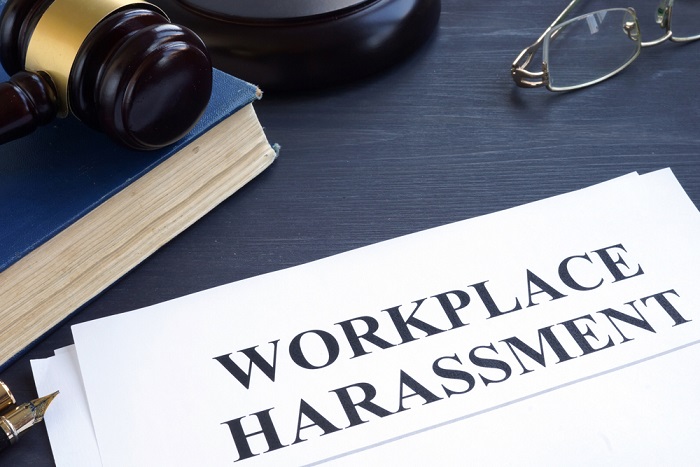Sexual harassment at workplace, once seldom acknowledged, is now more openly confronted and remedied. The passage of laws and a series of legal decisions have clarified employees’ rights and employers’ responsibilities.

In the past, behavior that intimidated and interfered with a person’s ability to work was rarely questioned: now there is legal redress for victims of sexual harassment. Similarly, employers were once rarely held responsible for the sexually harassing behavior of their employees: today, employers know that they can be held liable for the actions of their staff and have developed policies and grievance procedures to swiftly address the problem.
What is sexual harassment?
Sexual harassment at workplace is an abuse of power used to demean a woman and to discount her work capabilities. Sexual harassment is illegal. Sexual harassment includes sexual advances, requests for sexual favors, and other physical conduct of a sexual nature when:
(a) Submission to or rejection of such advances, requests or conduct is made either explicitly or implicitly a term or condition of employment or as a basis for employment decision;
(b) Such conduct has the purpose or effect of interfering with work performance; or
(c) Such conduct has the purpose or effect of creating an intimidating, hostile, humiliating, or sexually offensive work environment.
Sexual harassment takes many forms and has a different impact upon each person. Common reactions of sexual harassment targets include: guilt, self-blame, anger, frustration, denial, decreased self-esteem and a loss of self-confidence.
Many who are sexually harassed experience physical and psychological effects of harassment, and the stress may affect their work habits as well as the ability to work. For instance, a victim may take more sick time to avoid the harasser or because she has developed backaches, ulcers, or migraine headaches. Many victims become depressed and introspective, and may have difficulties with their personal lives.
Sexual harassment is not invited and is never an expression of genuine affection. It is important to note that the attention is unwanted whereas flirting is a mutual exchange enjoyed by both people. As sexual harassment can be very subtle, a victim may not perceive certain disturbing behavior as sexual harassment.
The following guidelines may be helpful in determining whether certain behavior constitutes sexual harassment. When evaluating whether actions may constitute sexual harassment, the following questions should be asked:
- Would the person make the same statement (or action) if his/her boss were standing within earshot?
- Would the person like to see the comment published on the front page of the newspaper? (It could happen).
- Why does the person need to say or do it?
- What business of the organization is furthered?
Sexual harassment has effects on the victim, the harasser, and to the organization. Victims experience decreased job satisfaction and they are denied the opportunity to do their job effectively. The public perception of the organization may be affected if the sexual harassment incidences become known outside of the office.
Sexual harassment at workplace costs organizations money. Costs are incurred in at least four ways:
- Productivity is reduced as employees spend time and energy initiating or responding to sexual harassment – that translates to time away from work.
- Morale of both victims and observers can be severely damaged.
- Job turnover increases as victims often leave a job to avoid harassing behavior.
- Legal costs and court settlement costs.
Who is harassed? Who are the harassers?
Women comprise the overwhelming majority of sexual harassment victims. Occasionally, women harass men or other women, and men harass other men. However, anyone who is the target of sexual harassment may experience the guilt, anger and fear that victims express.

Women of all ages, races, and economic backgrounds can be victims of sexual harassment. Employees as diverse as construction workers, lawyers, managers and secretaries have all reported sexual harassment.
Often, those who rely most upon their income are the targets of sexual harassment, as they are perceived to be (and often are) particularly vulnerable. As sexual harassment is an abuse of power, the victim is singled out as the target of the harasser’s need to control.
Many feel that their need for economic security and survival necessitates putting up with the harassment. Often, women feel uncomfortable talking about sexual harassment, and may feel threatened or intimidated by the harasser.
Consequently, it can be difficult for a woman to confront the harasser. Some women have expressed tensions in their personal relationships when they have discussed the harassment with a partner.
Common responses from a partner include: “What did you do to provoke the behavior?” or “Did you dress in a provocative manner to encourage the behavior?” These responses often increase the guilt and self-blame that many victims experience.
While the majority of harassers are men, all harassers are in a position of power or believe that they are more powerful than the victim. Reasons given by harassers to explain their behavior include:
- Feel inn threatened by the target (e.g. the target is advancing in the company)
- Feeling pressure from their supervisor and consequently wanting to exert power by controlling someone else
- Experiencing a difficult relationship and questioning their ability to interact intimately (in these instances, the behavior is intended by the harasser to be complementary rather than what it is – harassment)
- Personally disliking the victim
- Believing that the behavior/ comments were just jokes
Occasionally, sexual harassment may be the result of ignorance or insensitivity. Harassment at the workplace that had not been questioned in the past is now considered unacceptable by employees and subject to legal guidelines. Ignorance does not excuse a person’s behavior. Public education on what constitutes sexual harassment and the effects upon victims may cause the behavior to stop.
What to do if you are being sexually harassed?
Because sexual harassment is often an emotional and complicated experience, victims often do not know where or who to turn to for assistance. Many targets of sexual harassment feel confused, guilty, and helpless.
One of the most important steps for a target of sexual harassment to do is to bring the situation to the attention of the appropriate person in the workplace as soon as possible. By notifying the sexual harassment officer, you have initiated the proper procedure and you have put the employer on notice that the situation is occurring and that it must be resolved.
While the proper administrative channels are crucial to the successful resolution of the situation, it is also important for victims to confront the harasser to relay disapproval of the behavior (this is not legally necessary).
By expressing your reaction to the incident at the outset, you are not only attempting to educate the harasser but you are also empowering yourself. This is often very difficult, as the victim may feel frightened, angry, vulnerable, and may fear retaliation.
Targets of sexual harassment may try to ignore the behavior in the hopes that the harassment will stop. This rarely happens. In some instances, a verbal request for the harassment to stop may resolve the situation.
Frequently, managerial intervention is necessary. Targets of sexual harassment should educate themselves on the company’s policy and grievance procedure.
The following guidelines reflect common procedures for bringing a sexual harassment complaint. If your workplace does not have a grievance procedure in place, bring it to the attention of your personnel department.

Guidelines for victims of sexual harassment
Talk to the harasser
- At the outset, clearly and firmly tell the harasser that his behavior is offensive and inappropriate and creates an intimidating work environment for you. Stress that you are not interested in his suggestions, and that you want the behavior to stop immediately.
- Label the harasser’s behavior as it happens. Sometimes, a harasser may say that the woman did not tell him he was doing anything wrong. You need to firmly say, “That’s harassment and it is interfering with my work.”
- Let the harasser know that you will take further action if the behavior does not stop.
Record the incident
- Document the incident as precisely as possible. Include names, times, location, and any specific phrases. It is important to note whether there were any witnesses.
- Describe any physical or emotional reactions you had to the incident.
- Maintain this information on your own paper, separate from a personal journal. Keep the record at your home.
- If you cannot speak to the harasser, you can write a letter and hand it to him personally in the presence of a witness.
- If you have spoken to the harasser, write a memo summarizing your conversation. Hand-deliver the memo in the presence of a witness. (Maintain originals of all correspondence – distribute copies only).
Build a support network
- Talk with friends and family members.
- Talk with co-workers that you trust. Often sexual harassment is not an isolated incident.
- Request written statements from witnesses
Talk to your union
- Discuss the situation with your union representative or steward.
- Present the representative with a copy of your documentation.
- File a grievance. Check your contract provisions for any time restrictions for filing a complaint. Some contracts include language on the time frame tor fi ling a grievance from the alleged act or occurrence.
Talk to the sexual harassment officer
Report to your organization’s sexual harassment officer if the harassment continues. Discuss the incident(s) and any actions that you have taken. The officer will then conduct an investigation.
Note: If your organization does not have a sexual harassment officer, contact your personnel office to determine the proper channels.
Proceed to the next management level
If the officer or supervisor fails to take action, take your complaint to the next level. Identify the proper person at your workplace and give that person a copy of your documentation. Record the names of all the supervisors that you have spoken with, and what actions they took. Include specifics: names, dates and times.
File a complaint
It is advisable to attempt to first resolve the situation through the internal procedures at your workplace.
If your employer does not take any action to stop the harassment, or if you are dissatisfied with the results of the investigation, file a complaint with one of the government agencies listed in the Resources section of this guide.
You may also wish to file a civil lawsuit in state or federal court.
Conclusion
While some forms of sexual harassment are blatant, many actions are subtle. Just as the target of sexual harassment may not realize that the behavior constitutes sexual harassment, the harasser may not be aware that his actions are offensive and illegal.
Increasingly, employers are providing their employees with educational materials on sexual harassment. Public education serves several important functions:
- Employees/employers learn what constitutes sexual harassment, the effects of harassment, and the appropriate grievance procedures developed for their workplace;
- All employees are informed of the consequences of sexual harassment to the harasser and the organization;
- A workplace free of sexual harassment must be created.